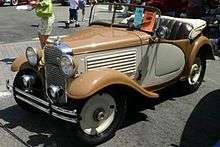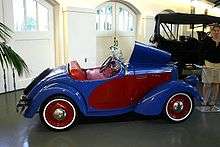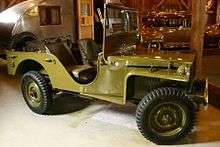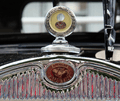American Austin Car Company
The American Austin Car Company was an American automobile manufacturing corporation. The company was founded in 1929, and produced motorcars licensed from the British Austin Motor Company from 1930 through 1934, when it filed for bankruptcy.
| Industry | Automobile |
|---|---|
| Fate | Acquired by American Rolling Mills |
| Founded | 1929 |
| Defunct | 1956 |
| Headquarters | Butler, Pennsylvania |
| Products | Vehicles |
| Website | www |

In 1935 the company was reorganized under the name American Bantam. Production resumed in 1937 and continued through 1941, including the first prototype of what later became the Jeep.[1]
History
American Austin Car Company was founded in 1929, in Butler, Pennsylvania, in premises that had belonged to the Standard Steel Car Company.[2] Their intention was to assemble and sell in the United States a version of the Austin 7 car, called American Austin.[3] After some initial success the Great Depression set in, and sales fell off to the point that production was suspended. In 1934 the company filed for bankruptcy.
The automobile was designed in the hopes of creating a market for small-car enthusiasts in the United States. The cars had 747 cc (45.6 cu in) inline-four engines, enabling the car to return 40 mpg‑US (48 mpg‑imp; 5.9 L/100 km), and travel 1,000 miles or 1,600 kilometres per 2 US qt (1.7 imp qt; 1.9 l) fill of oil.[4] It was capable of 50 mph (80 km/h) in high gear.[5] Styling resembled small Chevrolets, with Stutz- and Marmon-style horizontal hood louvres. The bodies were designed by Alexis de Sakhnoffsky and made by the Hayes Body Company of Detroit. The coupe was billed as a sedan, and sold for $445, slightly less than a Ford V8 roadster. The Great Depression made the cheaper secondhand cars more appealing, so sales dropped off.
More than 8,000 cars were sold during the company's first (and best) year of sales, but sales fell off to the point that production was suspended in 1932. It restarted in 1934 with bodies now made in-house, but stopped again between 1935 and 1937.
About 20,000 cars were produced.
Beginning in the 1960s, the car gained a following with hot rodders, as well as among drag racers. The 75 in (1,900 mm) wheelbase[5] made it attractive, even compared to the Anglia.
American Bantam

In 1935, Roy Evans, a former salesman for Austin, bought out the bankrupt company, which was reorganized under the name American Bantam. The formal connection with UK Austin was severed, though a relationship was maintained. A series of changes were made to the American Austin car design, including a modified engine and an exterior sheetmetal designed by Alexis de Sakhnoffsky.
Production was resumed in 1937, and continued through 1941. Despite a wide range of Bantam body styles, ranging from light trucks to woodie station wagons, only about 6,000 Bantams of all types were produced.
American Bantam's 1938 model was the inspiration for Donald Duck's car which was first seen in Don Donald (1937).
The Jeep prototypes and the dissolution of the company

American Bantam is credited with the design of the first Jeep by Karl Probst,[1][2] , and built 2675 of these. More than half of the initial production went to the British Army (and some to the Soviet Union). Some of the motors and chassis were imported from Toledo, Ohio; the original bodies were made at the American Bantam Car factory in Butler, Pennsylvania.
The Bantam company produced the most fuel-efficient engine and first prototype under the original US government tender specifications and was awarded the first contract, but because Willys Overland used a more powerful engine, and because elements favorable to Ford within the Quartermaster Corps claimed[6] that Bantam lacked production capacity to produce the vehicle on the scale needed by the United States Department of War, the awarding of ongoing contracts was reopened. Eventually the U.S. Army gave the BRC (Bantam Reconnaissance Car) 40 designs to Willys-Overland and awarded the bulk of orders to Willys and Ford,[7] while Bantam went on to produce Jeep trailers (T-3).
After Jeep production stopped, Bantam made two-wheel trailers. This continued until the company was taken over by American Rolling Mills in 1956.[2]
Gallery
 Another view of the 1939 American Bantam
Another view of the 1939 American Bantam Bantam Model 60 Coupé 1938
Bantam Model 60 Coupé 1938 Bantam Model 60 Roadster 1938
Bantam Model 60 Roadster 1938 Bantam Model 60 Convertible 1939
Bantam Model 60 Convertible 1939 American Bantam Model 60 Speedster Convertible 1939
American Bantam Model 60 Speedster Convertible 1939 An American Austin hood ornament
An American Austin hood ornament 1940 American Bantam engine and transmission
1940 American Bantam engine and transmission
References
- Borth, Christy (1945). Masters of Mass Production. Indianapolis, IN: Bobbs-Merrill. pp. 220–1.
- Georgano, N. (2000). Beaulieu Encyclopedia of the Automobile. London: HMSO. ISBN 1-57958-293-1.
- "First American Midget Car Runs At High Speed". Popular Mechanics. 53 (3): 368. September 1930. Retrieved 12 April 2015.
- Old Car Advertising Retrieved 12 September 2013
- Old Car Advertising Retrieved 12 September 2013
- Denfeld, D.; Fry, M. (1973). Indestructible Jeep. Ballantine Books. pp. 31–6, 41, 46. ISBN 9780345236210.
- Hartwell, Dickson (December 1960). "The Mighty Jeep". American Heritage Magazine. 12 (1). Retrieved 12 April 2015.
External links
| Wikimedia Commons has media related to American Austin / American Bantam. |
- AmericanBantam.com
- American Austin Bantam Club
- Austin & Bantam on wmpear.com
- Austin & Bantam on oldmotors.com
- American Bantam Photo Galleries at RemarkableCars.com
- Voice of America broadcast a report on the Bantam Jeep
- American Austin coupe at the Internet Movie Cars Database
- American Austin roadster at the Internet Movie Cars Database